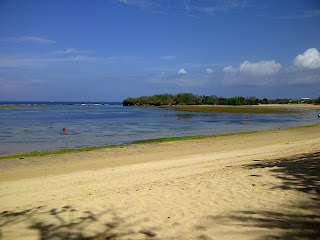INTERTIDAL BEACH OBSERVATION GUIDE FOR BEGINNER
I live in Indonesia, a tropical country. However, I used to not much of a beach person for I just can’t stand the intense heat of the beach. That was the main reason when my best friend and I decided that we would do a “cultural trip” only and promised to avoid the beaches on my first trip to Bali on February 2011. (Can you believe it? We went to BALI, the Island of Gods, which is famous for its great beaches and not planning to see any beach?)
Well, apparently Bali had a different plan for me. It’s like fate, my first time to Bali was actually the beginning of another 4 Bali trips on the 2011 alone. From then on, I just fall in love with Bali and its beautiful beaches, particularly the intertidal ones.Intertidal Beach
Intertidal beaches are rich ecosystems for marine wildlife. They are the place where organisms live between the low and high tide. The intertidal area of sea grass or rocky reef will be exposed at the low tide and thus available for observation without diving or snorkeling.
 |
Nusa Dua Beach, Bali
One characteristic of an intertidal beach is the long shoreline, in which the waves look far from the beach.
|
 |
| Nusa Dua Beach, Bali During the low tide, the intertidal area of sea grass is exposed . |
 |
| Nusa Dua Beach, Bali The coral reef and colorful algaes are visible during the low tide, |
Intertidal Beaches in Bali & Java
As a nature enthusiast, my favorite beach in Bali is Nusa Dua. The one that stretched between the Westin Resort to the Melia Hotel within the Bali Tourism Development Centre's (BTDC) complex. Some says this area is too artificial for it is so clean and sterile (unlike the common public beaches in Bali). I don’t mind though, for me, this beach is the tourist beach with the most pristine crystal clear water in Bali and its isolation preserves the marine wildlife in the intertidal area. If you look into the adjacent beach area of Tanjung Benoa, you will see how the area has been damaged by water sport and tourist activities.
Other intertidal beaches in Bali are includes Sanur Beach which located next to Nusa Dua Beach and Lovina Beach which located in the northern part of Bali. Some other intertidal beaches that I know in Java are Pantai Pameungpeuk in West Java, Pantai Sawarna in Banten and Pantai Ngobaran in Yogyakarta. ("Pantai" means "Beach" in Indonesian)
 |
| Tanjung Layar, Pantai Sawarna, Banten This magnificent scenery resembles the picture of land in some enchanted tales. |
| Sawarna Beach, Banten, Indonesia A rocky intertidal beach facing the Indian Ocean in the Southern part of Java. |
Best Time to Explore
| Nusa Dua Beach, Bali A swarm of baby fishes during the morning low tide. |
If you wish to find marine critters, it is best to explore during the morning low tide right after sunrise. You will find some nocturnal species on their way back to their hiding places. Around 9 am the coral reef fishes will be sighted swimming actively inside the low tide pools. On the other hand, the afternoon low tide is quiet and lack of marine critters sightings, except for the sharp spines of some sea urchins that are sticking out from underneath the rocks.
The night hunt is also great, especially during the full moon. However make sure you take extra safety measures:
- ensure you know the duration of the low tide (you don't want to get stuck when it's suddenly a high tide),
- don't go barefoot (you don't want to step on some diadema urchin or camouflaged stonefish)
- bring torch/ flash light,
- ensure you know the area where you wonder, avoid going to the area you are not familiar with,
- don't wonder alone in the area that you are not know well.
Dos & Don'ts
Intertidal areas are unique environments. Some areas are also very fragile; they can be easily damaged and take a long time to recover. To ensure we won't harm them, please note the following:
· After looking at organisms under rocks or seaweeds, cover up the organisms so the sun and air will not dry them out. Replace rocks in their original positions.
· Avoid walking on plants and animals whenever possible.
· Leave animals where you find them. Each animal is specialized to live in a certain habitat and may not survive if put in a different area.
· Avoid to touch bright-colored looking animals and the spiky ones for they might be poisonous.
· Avoid to touch polyclads (flatworms) for some of them are so fragile that they have developed self-destruction mechanism. Once disturbed, they will dissolve themselves into slime like substance. (http://www.rzuser.uni-heidelberg.de/~bu6/Introduction13.html )
Happy Looking! J




Keren blog-nya. Semoga hunting pantai, hewan laut, riset2 dan blognya maju dan makin lengkap. Sorry ndak pake boso londo, mboten ngertos :)
ReplyDeleteMatur nuwun, Pakde...
ReplyDeleteiya... mau riset lagi. Sengaja pake boso londo, meski masih awut-awutan tapi biar yg baca ga cuma pribumi hehe...
Masih jarang banget nature blog bikinan orang Indonesia. Padahal keanekaragaman hayati Indonesia luar biasa. Dari hutan tropis sampai laut dalam ada. Mohon bantuannya.. :)